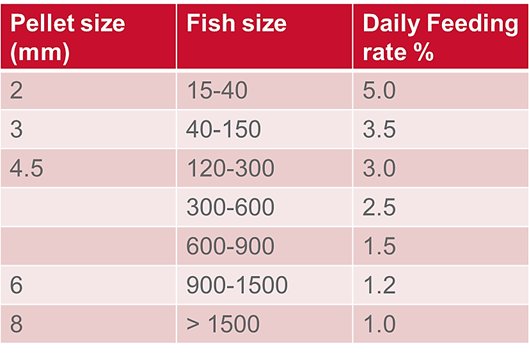This article will provide you with a catfish feeding chart for growing fish in Nigeria. It includes the amount of feed required to grow your catfish per day and can be used as a guide to plan your catfish farming business.
The table below indicates the amount of feed required to grow catfish in Nigeria.
The table below indicates the amount of feed required to grow catfish in Nigeria.
- Feeds containing between 25-32% protein are good as protein is the most expensive component in any feed formulation. The higher the protein content in a feed, the higher the overall cost of feeding. Catfish prefer feeds with 24-31% crude protein (CP).
- Catfish feeds should have at least 60% digestible nutrients (DIN), which include proteins, carbohydrates and lysine.
- It is recommended that you do not use common fish meal or soybean meal as they contain too much phosphorus, making them unsuitable for catfish cultures.
This is based on average daily weight gain of 50 grams (0.05kg) per day.
This is based on average daily weight gain of 50 grams (0.05kg) per day. This is the amount of feed required to grow catfish in Nigeria.
For example, starting with a weight of 100g, within 30 days the catfish will have gained approximately 1500g (1.5kg).
For example, starting with a weight of 100g, within 30 days the catfish will have gained approximately 1500g (1.5kg).
In order to calculate the amount of feed you need to give your catfish every day and week, simply follow these steps:
- Weigh your fish in grams or ounces and multiply by 2.068, then divide that number by 30 (days).
- This will give you the total amount of food needed per day: Grams*2.068/30 = daily food requirement in grammes/ounces
Feeding Chart for Catfish Growth in Nigeria
The table below indicates the amount of feed required to grow catfish in Nigeria. This is based on average daily weight gain of 50 grams (0.05kg) per day.
You can adjust the number of feeds per day, depending on your catfish’s growth rate, but don’t overfeed as this will lead to digestive problems and reduced growth rates.
So, a fish weighing 200g would require 4kg of feed by 30 days.
The flow chart below will help you calculate the amount of feed to add to your catfish tanks. Using this information, you can determine how much catfish food you need to purchase for your tank and how long it will last. For example, if a 200g fish requires 4kg of feed by 30 days then starting with 100g at day 1, it would have gained approximately 1500g (1.5kg) after 30 days!
Feeds containing between 25-32% protein are good as protein is the most expensive component in any feed formulation.
Feeds containing between 25-32% protein are good as protein is the most expensive component in any feed formulation. Feeds containing lower than 20% protein and greater than 35% are not acceptable.
Protein content of 20-30% is acceptable.
The following table gives tolerable ranges for different groups of fish:
The higher the protein content in a feed, the higher the overall cost of feeding.
Protein is the most expensive component in any feed formulation, so it’s important to keep your fish’s protein content between 25-32% (the higher the protein content in a feed, the higher the overall cost of feeding). However, since different species of fish have different growth rates and require different amounts of protein for optimal growth, you can adjust the amount of protein accordingly. For example, if you’re raising fish that grow slowly (e.g., tilapia or carp), then you may want to decrease their daily intake of protein in order to save money on feed costs. Conversely, if you’re raising fish that grow quickly (e.g., blue gill), then increase their daily intake of protein in order to optimize growth rate and prevent stunting due to insufficient nutrition.
Catfish Farming In Nigeria
The catfish is a freshwater fish that has become popular in Nigeria, and across the world. Catfish is a high-value fish that can be consumed directly or used to make other products such as fertilizer.
Catfish are also a good source of protein, calcium and iron (just like other types of fish). They also provide omega-3 fatty acids which are known to reduce the risk of heart disease and some types of cancer.
The table above shows the amount of feed required to grow catfish in Nigeria. This is based on an average daily weight gain of 50 grams (0.05kg) per day. For example, starting with a weight of 100g, within 30 days the catfish will have gained approximately 1500g (1.5kg). So, a fish weighing 200g would require 4kg of feed by 30 days. Feeds containing between 25-32% protein are good as protein is the most expensive component in any feed formulation. The higher the protein content in a feed, the higher the overall cost of feeding
